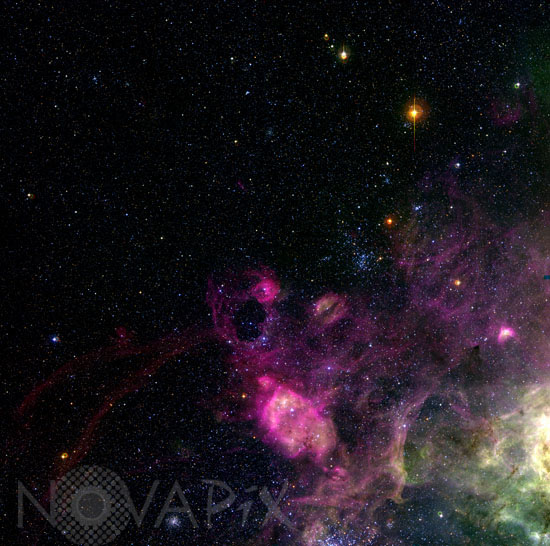Photo Agency - Astronomy - Space - Nature

Detail of the Tarentula nebula in Dorado
author: ESO/Novapix
reference: a-neb20-70006
Image Size 300 DPI: 70 * 70 cm
This image shows the turbulent region around the ring-shaped nebula DEM L 299 in the Large Magellanic Cloud, a satellite galaxy of the Milky Way system. It was produced by combining three monochromatic images obtained in December 2001 with the Wide-Field-Imager (WFI) at the ESO/MPG 2.2-m telescope at the La Silla Observatory. North is up and East is left. The coloured rings seen near some of the brighter stars in the field result from light reflections in the telescope optics. The Tarantula Nebula is one of the most impressive views in the Southern sky. Visible to the unaided eye in the Large Magellanic Cloud (LMC), a satellite galaxy of the Milky Way that is located in the direction of the southern constellation Doradus at a distance of about 170,000 light-years, this huge nebula is the prototype of what astronomers refer to as a "Giant HII region". In this complex of glowing gas and very hot and luminous stars, the gas is mainly composed of protons and electrons, which are kept apart by energetic photons emitted by the stars in this area. The Tarantula Nebula (also designated 30 Doradus) owes its name to the arrangement of its brightest patches of nebulosity that somewhat resemble the legs of a spider. They extend from a central "body" where a cluster of hot stars (designated "R136") resides that illuminate the nebula. This name, of the biggest spiders on the Earth, is also very fitting in view of the gigantic proportions of the celestial nebula - it measures nearly 1,000 light years across!
Contact : Stéphane Aubin +33-(0)9-51-26-53-76
© Novapix - All rights reserved


